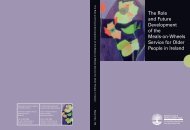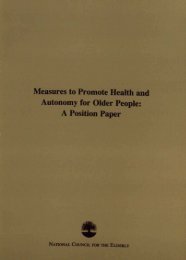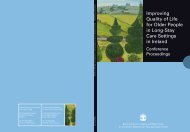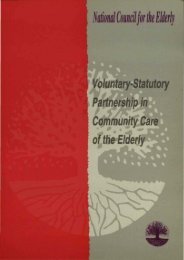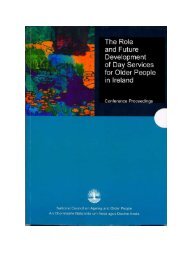From Ageism to Age Equality: Addressing the Challenges ...
From Ageism to Age Equality: Addressing the Challenges ...
From Ageism to Age Equality: Addressing the Challenges ...
You also want an ePaper? Increase the reach of your titles
YUMPU automatically turns print PDFs into web optimized ePapers that Google loves.
Presentations in <strong>the</strong> Final Session focused on:<strong>the</strong> status of age equality and non-discrimination in <strong>the</strong> EUimplementing equality for older people in Ireland.Conference OutcomesA number of key issues and challenges emerged from <strong>the</strong> conference presentations and discussionsessions.<strong><strong>Age</strong>ism</strong> ExistsPerhaps <strong>the</strong> most fundamental finding that emerged from several papers, including those of LorettaCrawley, Síle O’Connor and Eileen McGlone, is that ageism and age discrimination exist. They areembedded in our culture and attitudes. Everyone is responsible and tackling ageism is an issue forsociety as a whole.Prompt ActionIt was clear from <strong>the</strong> conference that <strong>the</strong> time <strong>to</strong> act is now. This message emerged strongly fromseveral papers and through comments made by delegates during <strong>the</strong> discussion sessions.We know that we are living in an ageing society. While <strong>the</strong>re are many reasons <strong>to</strong> act now, asRichard Baker showed in his paper, it is <strong>the</strong> economic and social impact of an ageing society that hasdriven <strong>the</strong> EU <strong>to</strong> take action on age discrimination. ‘If we fail <strong>to</strong> act now, <strong>the</strong>n more of us are going<strong>to</strong> be affected by ageism, and <strong>the</strong> more of us are affected, <strong>the</strong> greater <strong>the</strong> impact on our society’(Baker).3Building AwarenessBoth Craig Muir and Ros Levenson’s papers highlighted <strong>the</strong> fact that <strong>the</strong> first stage in tackling ageismis <strong>to</strong> acknowledge its existence and build awareness of it; people must understand and be able <strong>to</strong>recognise what ageism is and what it does.We saw, however, that many people find it difficult <strong>to</strong> identify ageism. Ros Levenson noted this in herpaper and it also emerged from <strong>the</strong> research findings presented by both Eileen McGlone and SíleO’Connor. The message was simple: ageism cannot be eliminated without raising awareness of whatit is and how it works. It is necessary <strong>to</strong> demonstrate what it means for individuals <strong>to</strong> be ageist andfor institutions or organisations <strong>to</strong> discriminate on <strong>the</strong> grounds of age.Why <strong><strong>Age</strong>ism</strong> Must Be EliminatedMany reasons were offered during <strong>the</strong> conference that amply explained <strong>the</strong> importance of eliminatingageism. <strong>Age</strong> discrimination erodes <strong>the</strong> values we espouse for our society, as well as for our healthand social services. It is, in fact, <strong>the</strong> anti<strong>the</strong>sis of <strong>the</strong>se values: it devalues and excludes people;<strong>From</strong> <strong><strong>Age</strong>ism</strong> <strong>to</strong> <strong>Age</strong> <strong>Equality</strong>: <strong>Addressing</strong> <strong>the</strong> <strong>Challenges</strong>








